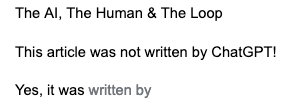The AI, The Human And The Loop: The Future Of Automation
This article was not written by AI.
Yes, a human wrote this article, which, looking at the gushing commentary across social media and office corners on the capabilities of ChatGPT indicates a non-AI article is going to be rare in the near future.
The truth, however, is that we have probably been assisted by AI longer than we realize. No sooner had I started typing in Google Docs than I was prompted to use this generated text to move my sentence along.

As you can see it was nothing fancy, but a nudge to help me write efficiently.
While AI has assisted humans for a while, there now stand business use cases where humans and machines can benefit each other, share responsibilities, and create a powerful hybrid solution that is greater than the sum of its parts.
This is the premise of human-in-the-loop machine learning. Simply put, human-in-the-loop machine learning (HITL ML) is a method that involves people providing input and oversight during the decision-making process of a machine learning model. This is the magic that makes automating complex processes seem like a breeze.
Is it really automated if it involves people?
By now you are aware that in machine learning, models are trained using large amounts of data, which the model uses to make predictions or decisions. However, the accuracy of the model's predictions can be limited by the quality of the data used to train it. More importantly, organizations don’t always have access to large amounts of training data.
This is where human input becomes crucial.
Even with large amounts of training data, it is important to remember data science is a tool and not a means to an end. Machine predictions don’t exist in the realm of absolute, this is the valley of probabilities. Managers and decision-makers will need to embrace this fact. The good news is that with our guidance and expertise, we can train machine-learning models to mimic our decision-making processes more accurately.
How does human-in-the-loop machine learning work in document processing?

Imagine you are a teacher and you have a new student in your class who is very good at math but not so good at spelling. You want to help the student improve in both areas, so you give them a math problem to solve and a spelling test to take. The student gets most of the math problems right but makes a lot of spelling mistakes.
You decide to use teacher-in-the-loop learning to help the student improve. You review the spelling test with the student and point out where they made mistakes. Then, you have them redo the test, but this time you give them a hint when they make a mistake. With your guidance, the student does better on the test the second time.
Similarly, in intelligent document processing, the ML model is the student and the documents are the math problems and spelling tests. The model may be good at categorizing documents, but not so good at understanding edge case information from them. By using human-in-the-loop machine learning, humans can review the model’s output and correct any mistakes. This feedback helps the ML model to learn and improve, just like the student in the classroom.
How does Infrrd combine human-in-the-loop machine learning and document processing?
While we extract data with a very high level of accuracy and also offer No-Touch Processing for 100% accurate processing, there are cases where having a human in the loop can offer phenomenal ROI.
Let’s take a look at when this human-in-the-loop check can be very helpful:
- Messy documents: Documents that cannot be read by OCR engines, have low scan quality
- Safety net for financial decisions: When you need to make payments based on what you read from invoices or take a mortgage decision based on a loan application
- Complex tables and line items: Nested tables, or tables with complex layouts always get tricky
- When incorrect data is just not an option: When it comes to critical data to feed a business process, it does not matter if it takes a little more time but the extracted data has to be absolutely correct
Most of our customers start by using our AI engine to process documents over an API. As they see more and more documents getting processed through No-Touch Processing, they are happy to hand over the few remaining documents to our data verification team. Every time the team makes a correction on the document, our engine learns from it and reduces these errors over time. It gives you all the benefits of a BPO but costs much less because the heavy lifting is already done by our AI engine. If you’re looking for 100% accurate data extraction, ring us up!
The problem with traditional automation solutions
Clearly, artificial intelligence is having a moment. According to the 2023 AI Index Report, employers in the United States are increasingly looking for workers with AI-related skills. Across every sector in the US, the number of AI-related job postings has increased on average from 1.7% in 2021 to 1.9% in 2022.
With various industries implementing automation to streamline their processes and increase efficiency, businesses learned that traditional automation solutions often rely on pre-programmed rules and rigid algorithms that can't adapt to new situations. This led to costly inaccuracies, errors, and inefficiencies. Moreover, traditional automation solutions lack the ability to learn and improve over time. They can only perform the tasks they were programmed to do, which limits their usefulness in dynamic environments.
This is where machine learning comes in, allowing automation solutions to learn from data and improve their performance. However, even the most advanced machine learning algorithms have their limitations, and can only go so far without human input.
Human-in-the-loop machine learning enables humans to provide feedback and guidance to the machine learning algorithms, ensuring that they are accurate and relevant. This approach not only improves the accuracy of automation solutions but also enables them to adapt to new situations and learn from feedback. This makes them more responsive, efficient, and effective. By leveraging the strengths of both humans and machines, human-in-the-loop machine learning is transforming the way we approach automation solutions.
The advantages of human-in-the-loop machine learning for document automation
Human-in-the-loop machine learning offers several advantages over traditional automation solutions. Here are some of the key benefits:
1. Improved accuracy and efficiency
By incorporating human oversight and input into intelligent document processing solutions, HITL ML can improve both accuracy and efficiency. Machine learning algorithms can automate the bulk of document processing tasks, but humans can intervene when needed to correct errors or make judgments that machines may not be able to. This can help reduce errors and ensure that the output of IDP solutions is reliable and accurate.
2. Enhanced flexibility
Document processing solutions can be tailored to specific industries and use cases, but they can also be inflexible in certain situations. With HITL ML, humans can provide feedback and make adjustments to the algorithms in real-time, allowing for greater flexibility and customization. This can be particularly important in industries with complex and changing regulations
3. Increased security and privacy
Businesses have concerns about the security and privacy of sensitive information. With HITL ML, humans can oversee and monitor the processing of sensitive documents, ensuring that they are handled in a secure and confidential manner. Additionally, humans can help identify and mitigate potential security risks, providing an extra layer of protection for the enterprise.
4. Enhanced user experience
Intelligent Document Processing solutions can be complex and difficult to use for non-technical users. With HITL ML, human oversight and input can help improve the user experience by making the solution more intuitive and user-friendly. This can help increase adoption rates and ensure that the IDP solution is effectively used across the enterprise.
5. Improved ROI
Finally, by incorporating HITL ML into IDP solutions, enterprises can see a higher return on investment. The improved accuracy and efficiency can help reduce costs associated with manual processing, while the enhanced user experience can increase adoption rates and lead to greater productivity. Additionally, the flexibility and customization provided by HITL ML can help ensure that the IDP solution is optimized for the specific needs of the organization, maximizing its value.
The impact of human-in-the-loop machine learning on job roles
Albert Einstein once said, “Everything should be made as simple as possible, but not simpler”. As automation solutions become more sophisticated in handling repetitive tasks, humans will be empowered to focus their attention on only complex problems that require their expertise - leading to significant time and cost savings for businesses, as well as improved job satisfaction for employees.
In an optimistic outlook from Harvard Business Review, as computers become more capable of performing repetitive tasks that are commonly assigned to entry-level employees, more roles focused on complex tasks with competitive salaries will arise in their place. This means that young professionals will have a wider range of interesting and rewarding career options to choose from.
As we move into the future, the collaboration between humans and machines will become ever more important, delivering an ecosystem where safety is never sacrificed for the sake of automation - a system that can be monitored by humans to ensure you always get human-level precision. With human-in-the-loop, you can trust that your documents will be processed quickly and reliably, giving you peace of mind and the ability to focus on other important tasks.
Human-in-the-loop machine learning is a game-changer that's here to stay, and businesses that embrace this technology will be well-positioned for success in the years to come.
FAQs
A pre-fund QC checklist is helpful because it ensures that a mortgage loan meets all regulatory and internal requirements before funding. Catching errors, inconsistencies, or compliance issues early reduces the risk of loan defects, fraud, and potential legal problems. This proactive approach enhances loan quality, minimizes costly delays, and improves investor confidence.
A pre-fund QC checklist is a set of guidelines and criteria used to review and verify the accuracy, compliance, and completeness of a mortgage loan before funds are disbursed. It ensures that the loan meets regulatory requirements and internal standards, reducing the risk of errors and fraud.
IDP (Intelligent Document Processing) enhances audit QC by automatically extracting and analyzing data from loan files and documents, ensuring accuracy, compliance, and quality. It streamlines the review process, reduces errors, and ensures that all documentation meets regulatory standards and company policies, making audits more efficient and reliable.
IDP continuously updates its machine learning models by analyzing user interactions and document processing outcomes, leading to ongoing improvements in accuracy and efficiency.
By streamlining document processing and reducing manual intervention, machine learning in IDP lowers operational costs and improves overall efficiency.
IDP employs machine learning algorithms to adapt and improve extraction methods based on historical data and user feedback, enhancing performance over time.







